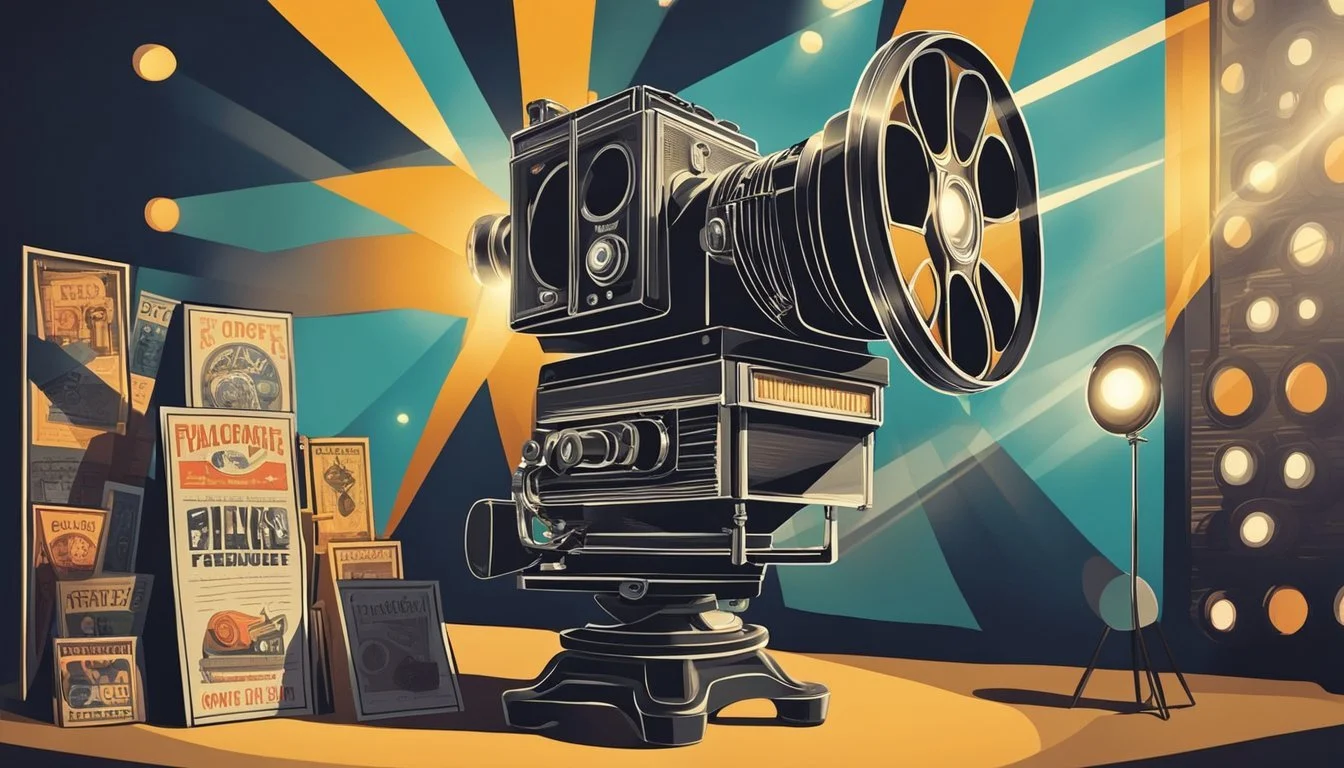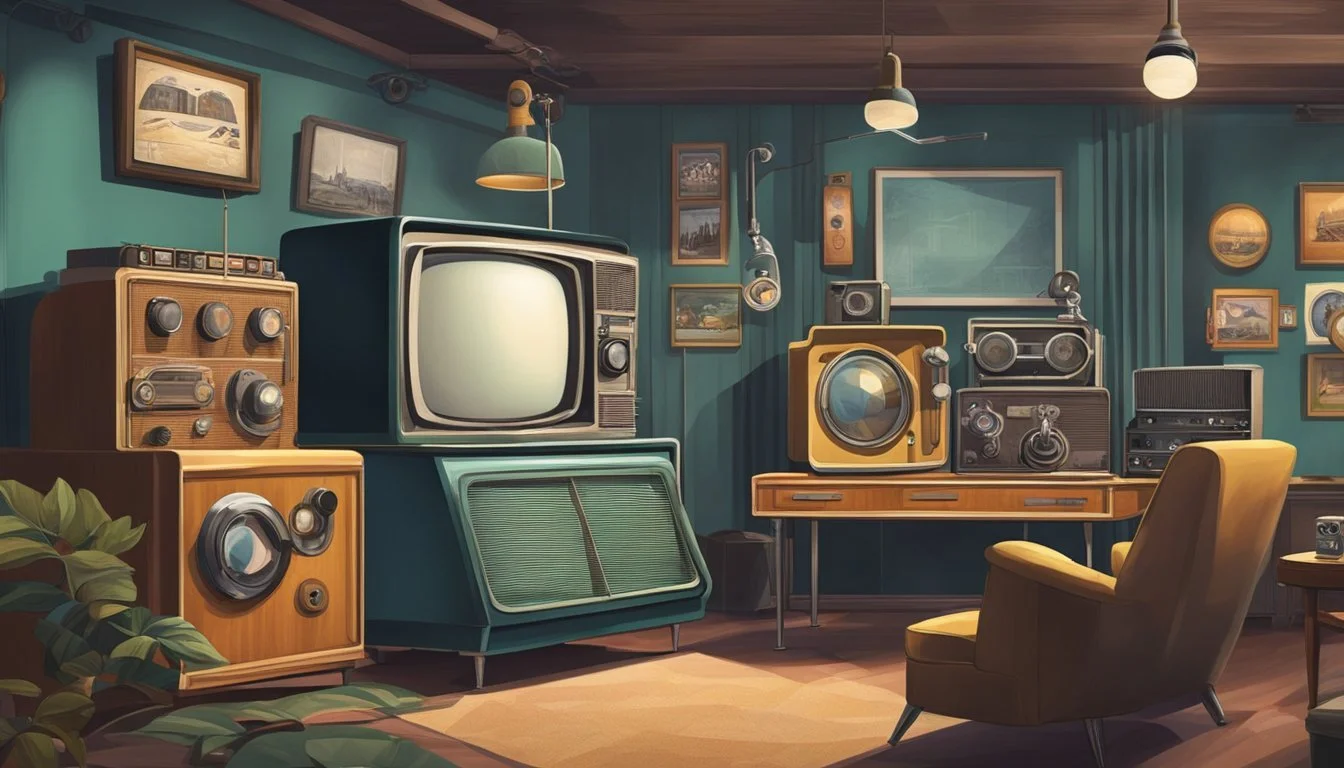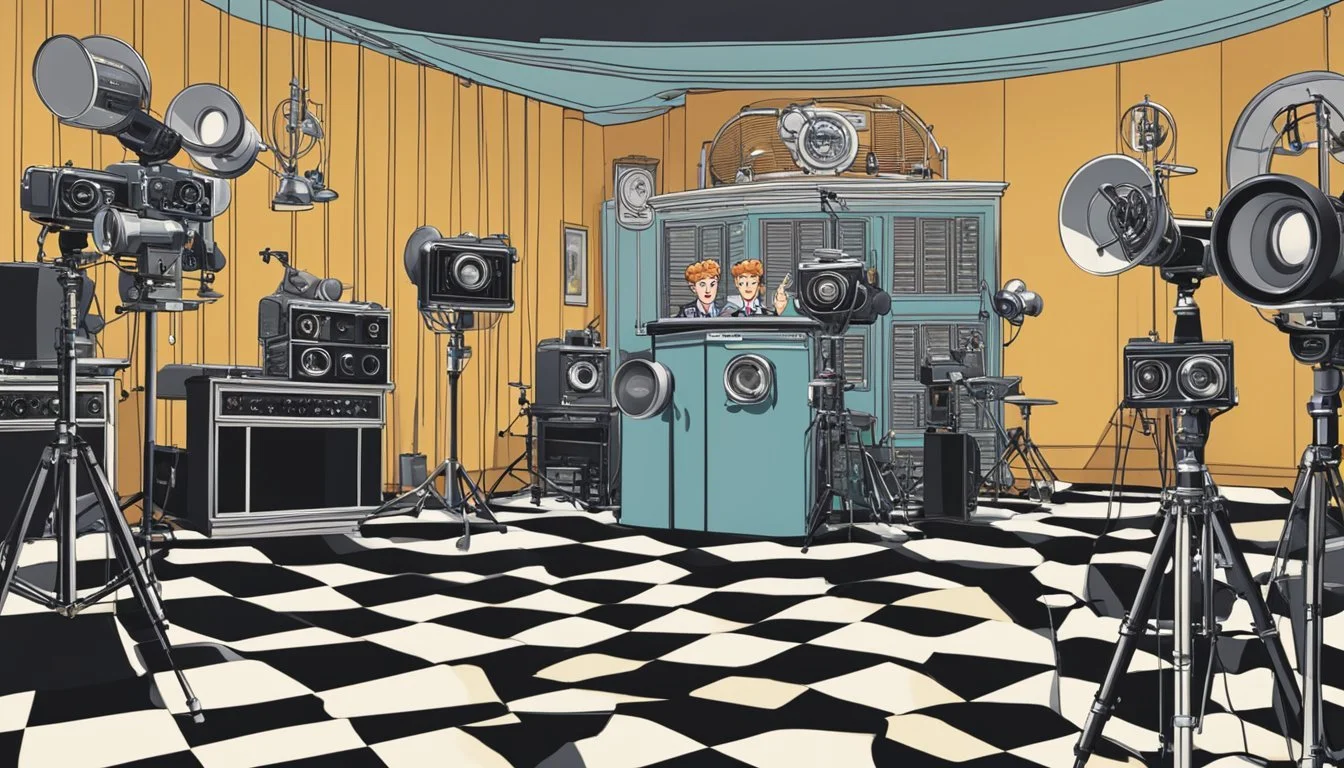Lights, Camera, Lucille: The Real Story of 'Being the Ricardos'
Unveiling Hollywood's Golden Age
Aaron Sorkin's "Being the Ricardos" offers a glimpse into the lives of television icons Lucille Ball and Desi Arnaz. The film focuses on a tumultuous week during the production of their hit show "I Love Lucy," blending personal and professional challenges.
The movie dramatizes three pivotal moments in the couple's lives, including Lucille Ball's encounter with accusations of being a Communist. This real-life incident occurred in 1953 when Ball admitted to registering to vote as a Communist in 1936. The film explores how this revelation threatened their careers and the future of their beloved sitcom.
While "Being the Ricardos" aims to portray the true story of Ball and Arnaz, it takes some creative liberties with historical events. The film compresses multiple incidents into a single week for dramatic effect, highlighting the pressures and complexities faced by the famous couple both on and off screen.
Origins and Background
"Being the Ricardos" draws inspiration from the iconic sitcom "I Love Lucy" and its stars Lucille Ball and Desi Arnaz. The film explores the personal and professional lives of this pioneering couple who shaped television history.
Development of 'Being the Ricardos'
Aaron Sorkin, known for his sharp dialogue and political dramas, took on the challenge of bringing the Ricardos' story to the big screen. He wrote the screenplay and directed the film, aiming to capture a pivotal week in the lives of Lucille Ball and Desi Arnaz.
The project attracted high-profile talent, with Nicole Kidman cast as Lucille Ball and Javier Bardem as Desi Arnaz. Sorkin's approach focused on dramatizing three key moments in the couple's lives, weaving them into a narrative set during one production week of "I Love Lucy."
'I Love Lucy': A Cultural Phenomenon
"I Love Lucy" premiered in 1951 and quickly became a television sensation. The show starred Lucille Ball as Lucy Ricardo and Desi Arnaz as Ricky Ricardo, a married couple navigating comedic situations in New York City.
The sitcom broke new ground with its innovative filming techniques and multicultural cast. It was one of the first shows to use three cameras simultaneously, allowing for seamless editing and capturing the live audience's reactions.
Ball's physical comedy and the show's witty writing contributed to its immense popularity. "I Love Lucy" consistently topped ratings charts and remains beloved through syndication decades after its original run.
Casting and Characters
The casting choices for "Being the Ricardos" brought iconic television personalities to life on the big screen. A-list actors took on the challenge of portraying beloved figures from "I Love Lucy" and captured their essence.
Lucille Ball: Nicole Kidman's Portrayal
Nicole Kidman stepped into the shoes of comedy legend Lucille Ball. The Oscar-winning actress faced initial skepticism from fans but delivered a nuanced performance. Kidman focused on Ball's work ethic and business acumen rather than attempting a direct impression.
She studied Ball's mannerisms and vocal patterns to embody her character. Kidman's portrayal highlighted Ball's strength and determination in a male-dominated industry.
Desi Arnaz: Javier Bardem Steps In
Javier Bardem took on the role of Desi Arnaz, bringing charm and energy to the Cuban-born actor and musician. Bardem captured Arnaz's charisma and business savvy, showcasing his importance to the success of "I Love Lucy."
The Spanish actor worked on his accent and studied Arnaz's performances to authentically portray the TV star. Bardem's chemistry with Kidman helped bring the Ball-Arnaz relationship to life on screen.
Supporting Cast: Vivian Vance and William Frawley
J.K. Simmons and Nina Arianda portrayed William Frawley and Vivian Vance, who played Fred and Ethel Mertz on "I Love Lucy." Simmons captured Frawley's gruff exterior and dry wit, while Arianda embodied Vance's comedic timing and complex relationship with Ball.
The film depicts the tensions between cast members, particularly Vance's frustrations with her character's frumpy appearance. It also touches on Frawley's reputation for enjoying a drink, adding depth to these beloved supporting characters.
Politics and Controversies
The 1950s brought political turmoil to Hollywood, with accusations of Communist sympathies threatening careers. Lucille Ball found herself unexpectedly caught up in these tensions.
The Red Scare and Hollywood Blacklist
The Red Scare gripped America in the early 1950s, fueled by fears of Communist infiltration. Hollywood became a prime target for investigations. The House Un-American Activities Committee (HUAC) led aggressive inquiries into the film industry.
Many actors, writers, and directors faced accusations of Communist ties. Those who refused to cooperate often found themselves blacklisted, unable to work in the industry. The blacklist created an atmosphere of suspicion and fear in Hollywood.
Lucille Ball's Communist Accusations
In 1953, Lucille Ball faced allegations of Communist affiliations. The accusations stemmed from her 1936 voter registration as a Communist Party member. Ball admitted to HUAC investigators that she had registered, but claimed it was to please her socialist grandfather.
The scandal threatened Ball's career and the future of "I Love Lucy." However, her husband Desi Arnaz publicly defended her. He famously quipped, "The only thing red about Lucy is her hair, and even that's not legitimate."
HUAC and the Film Industry
HUAC's investigations profoundly impacted Hollywood. The committee subpoenaed numerous industry figures to testify about alleged Communist activities. J. Edgar Hoover, FBI director, took a keen interest in these proceedings.
Some, like director Elia Kazan, chose to name names of suspected Communists. Others refused, facing contempt charges and career ruin. The investigations created a climate of fear and self-censorship in the film industry.
Influential gossip columnist Walter Winchell often used his platform to amplify anti-Communist sentiment. His reports could make or break careers during this tense period.
Creative Process
The creation of "Being the Ricardos" involved meticulous attention to historical detail and innovative filmmaking techniques. From script to screen, the production team worked to authentically capture the 1950s era of "I Love Lucy" while bringing a fresh perspective to the story.
Writing and Direction by Aaron Sorkin
Aaron Sorkin, known for his sharp dialogue and complex characters, took on the dual role of writer and director for "Being the Ricardos." He crafted a script that blended fact and dramatic license, focusing on a pivotal week in the lives of Lucille Ball and Desi Arnaz.
Sorkin's approach centered on three key events: Ball's Communist accusations, a pregnancy announcement, and Arnaz's alleged infidelity. He structured the narrative to explore these challenges within the context of producing an "I Love Lucy" episode.
The director's signature rapid-fire dialogue and walk-and-talk scenes found their way into the film, adding a dynamic energy to the behind-the-scenes portrayal of television production.
Rebuilding the 1950s 'I Love Lucy' Era
Recreating the world of "I Love Lucy" required extensive research and attention to detail. The production design team meticulously reconstructed the CBS television studio where the show was filmed.
Period-accurate cameras, lighting equipment, and props were sourced or recreated to ensure authenticity. Costume designers crafted outfits that mirrored the iconic looks of Lucy and Ricky Ricardo, as well as the fashion of the era.
The team also recreated the Ricardos' home set, paying close attention to furniture, decor, and household items typical of the 1950s. This attention to detail helped immerse the audience in the time period.
Filming Techniques: From Kinescope to Prime Video
"Being the Ricardos" employed a blend of modern and vintage filming techniques to capture the essence of 1950s television production. The film showcases the three-camera system pioneered by Desi Arnaz for "I Love Lucy."
Cinematographers used period-appropriate lenses and lighting setups to mimic the look of early television. They also incorporated shots of vintage kinescope copies to authentically represent how viewers experienced the show at home.
For scenes set in the present day of the film, modern digital cameras were used to create a visual contrast. The film's final presentation on Prime Video allowed for high-definition viewing while still honoring the original look of "I Love Lucy."
The Ricardos: Relationship Dynamics
Lucille Ball and Desi Arnaz's relationship was a complex blend of personal and professional ties. Their marriage and creative partnership shaped both their lives and the entertainment industry.
Marriage and Divorce: Lucy and Desi's Story
Lucy and Desi's romance began on the set of "Too Many Girls" in 1940. They eloped just months later, embarking on a passionate but tumultuous marriage. Despite their deep love, the couple faced challenges including Desi's infidelity and heavy drinking.
Their work on "I Love Lucy" brought them closer for a time. The show's success allowed them to spend more time together, with Desi playing Lucy's on-screen husband.
However, the pressures of fame and their demanding careers took a toll. After 20 years of marriage, Lucy and Desi divorced in 1960. Despite the split, they remained friends and business partners.
Working Relationship: Desilu Productions
Lucy and Desi co-founded Desilu Productions in 1950. This groundbreaking venture made them pioneers in the television industry. Desilu produced hit shows like "Star Trek" and "Mission: Impossible."
Their professional synergy was undeniable. Lucy's comedic talent and Desi's business acumen proved a powerful combination. They innovated TV production techniques, including the use of multiple cameras.
After their divorce, Lucy bought out Desi's share of Desilu in 1962. She became the first woman to run a major television production company. Their creative legacy continued to thrive even after their personal relationship ended.
Assessing Historical Accuracy
"Being the Ricardos" blends fact and fiction to dramatize key events in Lucille Ball and Desi Arnaz's lives. The film tackles sensitive social issues while taking some creative liberties with the timeline and details.
Fact vs. Fiction: Depicting Lucille and Desi
The movie condenses several real-life events into a single week for dramatic effect. Lucille Ball's Communist Party registration, which occurred in 1936, is portrayed as a more immediate threat to her career. The film accurately depicts Ball's testimony to the House Un-American Activities Commission, where she admitted to registering as a Communist.
Desi Arnaz's alleged infidelity is highlighted, though the specific Confidential magazine article mentioned in the film is fictionalized. The movie captures the essence of the couple's complex relationship but takes liberties with the timing of certain events.
Representation of Social Issues
"Being the Ricardos" tackles racial discrimination faced by Desi Arnaz as a Cuban-American in the entertainment industry. The film accurately portrays the groundbreaking nature of their interracial marriage on television.
The Red Scare and its impact on Hollywood are central themes. The movie effectively conveys the fear and paranoia surrounding Communism in the 1950s, though it compresses the timeline of Ball's HUAC testimony.
Gender roles in the television industry are explored through Lucille Ball's fight for creative control and recognition as a comedic talent beyond her on-screen persona.
Legacy and Impact
Lucille Ball and Desi Arnaz's influence on television and popular culture extends far beyond their time. Their groundbreaking work continues to shape entertainment and resonate with audiences today.
Influence on Modern Television and Cinema
'I Love Lucy' set the standard for sitcom production and storytelling. The show pioneered the three-camera setup, now a staple in TV comedies. Its innovative use of film instead of kinescope allowed for high-quality reruns, establishing a lucrative syndication model.
Ball's physical comedy and Arnaz's musical talents inspired generations of performers. Their on-screen chemistry became a blueprint for romantic comedies. The show's humor transcended cultural barriers, paving the way for diverse representation in media.
Modern historical dramas like 'Being the Ricardos' continue to explore the Ricardos' legacy. These films offer new perspectives on the challenges they faced behind the scenes.
Reflection on the Ricardos' Cultural Significance
Lucille Ball broke gender barriers as one of the first female studio executives. Her success opened doors for women in the entertainment industry. Desi Arnaz's portrayal of Ricky Ricardo challenged stereotypes about Cuban-Americans.
The couple's interracial marriage on prime-time television was revolutionary for its time. It helped normalize mixed relationships in American society. Their personal struggles, including navigating the Cuban Revolution's impact on Arnaz's family, added depth to their public personas.
'I Love Lucy' remains a cultural touchstone, with catchphrases and iconic scenes embedded in popular consciousness. The show's enduring popularity speaks to its timeless humor and relatable characters.
Conclusion
"Being the Ricardos" offers a captivating glimpse into the lives of Lucille Ball and Desi Arnaz. The film dramatizes pivotal moments in their careers and relationship during a tumultuous week of "I Love Lucy" production.
While the movie takes some creative liberties, it accurately portrays key events like Ball's Communist accusations. The 1953 investigation by the House Un-American Activities Commission is faithfully depicted.
Nicole Kidman and Javier Bardem bring Ball and Arnaz to life on screen. Their performances capture the essence of the iconic couple's dynamic both on and off camera.
Aaron Sorkin's direction blends fact and dramatic interpretation. The film condenses multiple real-life events into a single week, creating a compelling narrative structure.
"Being the Ricardos" sheds light on the challenges faced by Ball and Arnaz as pioneering figures in television. It explores their personal struggles alongside their professional triumphs.
The movie serves as a tribute to the enduring legacy of "I Love Lucy" and its stars. It reminds viewers of the cultural impact Ball and Arnaz had on American entertainment.






